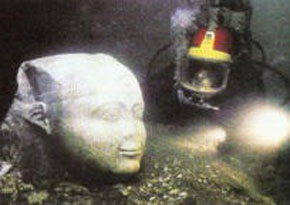 Plunging into the waters off Egypt's resort of Alexandria, divers explored the submerged ruins of a palace and temple complex from which Cleopatra ruled, swimming over heaps of limestone blocks hammered into the sea by earthquakes and tsunamis more than 1,600 years ago, according to The Associated Press
Plunging into the waters off Egypt's resort of Alexandria, divers explored the submerged ruins of a palace and temple complex from which Cleopatra ruled, swimming over heaps of limestone blocks hammered into the sea by earthquakes and tsunamis more than 1,600 years ago, according to The Associated Press
Researchers exploring undersea treasure in Egypt
By-Egypt News
Home News
00:05
Sunday ,30 May 2010

The international team is painstakingly excavating one of the richest underwater archaeological sites in the world and retrieving stunning artifacts from the last dynasty to rule over ancient Egypt before the Roman Empire annexed it in 30 B.C.
Using advanced technology, the team is surveying ancient Alexandria's Royal Quarters, encased deep below the harbor sediment, and confirming the accuracy of descriptions of the city left by Greek geographers and historians more than 2,000 years ago.
Since the early 1990s, the topographical surveys have allowed the team, led by French underwater archaeologist Franck Goddio, to conquer the harbor's extremely poor visibility and excavate below the seabed.
They are discovering everything from coins and everyday objects to colossal granite statues of Egypt's rulers and sunken temples dedicated to their gods.
"It's a unique site in the world," said Goddio, who has spent two decades searching for shipwrecks and lost cities below the seas.
The finds from along the Egyptian coast will go on display at Philadelphia's Franklin Institute from June 5 to Jan. 2 in an exhibition titled "Cleopatra: The Search for the Last Queen of Egypt."
Many archaeological sites have been destroyed by man, with statues cut or smashed to pieces. Alexandria's Royal Quarters -- ports, a cape and islands full of temples, palaces and military outposts -- simply slid into the sea after cataclysmic earthquakes in the fourth and eighth centuries.
Goddio's team found it in 1996. Many of its treasures are completely intact, wrapped in sediment protecting them from the saltwater.
"It's as it was when it sank," said Ashraf Abdel-Raouf of Egypt's Supreme Council of Antiquities.
Tuesday's dive explored the sprawling palace and temple complex where Cleopatra, the last of Egypt's Greek-speaking Ptolemaic rulers, seduced the Roman general Mark Antony before they committed suicide upon their defeat by Octavian, the future Roman Emperor Augustus.
Dives have taken Goddio and his team to some of the key scenes in the dramatic lives of the couple, including the Timonium, commissioned by Antony after his defeat as a place where he could retreat from the world, though he killed himself before it was completed.
Divers photographed a section of the seabed cleared of sediment with a powerful suction device. Their flashlights glowing in the green murk, the divers photographed ruins from a temple to Isis near Cleopatra's palace on the submerged island of Antirhodos.
On the boat's deck, researchers displayed some small recent finds: imported ceramics and local copies, a statuette of a pharaoh, bronze ritual vessels, amulets barely bigger than a fingernail.
Alexandria's Eastern Harbor was abandoned after another earthquake, in the eighth century, and was left untouched as an open bay -- apart from two 20th century breakwaters -- while modern port construction went ahead in the Western Harbor. That has left the ancient Portus Magnus undisturbed below.


